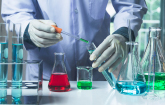BOSTON, Aug. 18, 2023 /PRNewswire/ -- By now, antimicrobial technologies are well known to the general public, being applied to products ranging from antimicrobial coatings to protect people from bacteria and viruses lingering on high-touch surfaces to antimicrobial infused shirts and socks to help limit malodor. IDTechEx's market research report, "Antiviral and Antimicrobial Technology Market 2023-2033", finds that though the field of antimicrobial technology is broad, the majority of established companies in the space focus on antimicrobial metal ions such as silver. Despite their high level of efficacy, there are several reasons to look beyond silver, such as concerns over its environmental impact. IDTechEx examines several alternative approaches in its report, following three central themes.
Bio-Based Antimicrobial Technologies
One of the approaches companies have taken in developing antimicrobial technologies beyond silver is to look towards nature for inspiration. Relatively few companies are active in this space, and each focuses on developing their own bio-based antimicrobial material. Recent product launches from major players may help to draw more attention to these bio-sourced alternatives, and the marketing often focuses on the materials' sustainability and eco-friendliness. Examples of commercialized products include plant-based antimicrobials such as citric acid and essential oils from thyme and peppermint, all of which have been known for decades for their antimicrobial properties.
Another bio-based approach, one that is not yet commercialized, involves the use of immobilized antimicrobial peptides (AMPs). AMPs are short amino acid sequences found in nature that have broad antimicrobial efficacy. While promising, the majority of research and development into AMPs focus on therapeutic applications. For example, several antibiotics on the market today are AMPs.
Immobilizing Disinfectants
Outside of immobilizing silver ions, companies have also commercialized technologies that leverage commonly used disinfectants. The most widely commercialized antimicrobial technology based on this approach is, of course, silane quaternary ammonium compounds, where the silane moiety enables the functionalization of surfaces with a covalently attached disinfectant, the quaternary ammonium. Si-quats, as they are also known, are the second most common antimicrobial technology after silver.
The key difference between antimicrobials such as silver and disinfectants is the potential for a speedier response to microorganisms. Disinfectants act much more quickly than antimicrobials, in the order of minutes versus hours. Outside of utilizing polymerization chemistry to immobilize disinfectant compounds, other approaches include the immobilization of depots from which disinfectants such as hydrogen peroxide can be stored and released, as well as surfaces that are especially designed to capture and release chlorine. Unlike the depot, which can be depleted, the latter approach allows for regular renewable of the surface using commonly available chlorine-containing sanitizers.
Generating Reactive Oxygen Species
A third approach of interest is the photocatalytic creation of reactive oxygen species (ROS). ROS are routinely produced by living organisms as a part of their natural defense. For example, several cell types within the human immune system, including neutrophils and mononuclear phagocytes, produce ROS to fight invading microorganisms. Commercialized antimicrobial technologies that leverage the destructive effect of ROS typically utilize photocatalysis to generate the ROS. The most common approach is to utilize titanium dioxide, which catalyzes the reaction of ROS upon exposure to UV light. While there are many positives associated with the use of titanium dioxide, such as the fact that it is not depleted in the creation of ROS, it is environmentally friendly, sustainable, low cost, and has a low possibility of generating antimicrobial resistance. The most obvious fact is that the surface only works when exposed to UV light.
IDTechEx's latest report on antiviral and antimicrobial technologies analyzes over 100 companies active in this area, including companies developing the technologies listed in this article. To find out more about this report, including downloadable sample pages, please visit www.IDTechEx.com/antimicrobial.
About IDTechEx
IDTechEx guides your strategic business decisions through its Research, Subscription and Consultancy products, helping you profit from emerging technologies. For more information, contact research@IDTechEx.com or visit www.IDTechEx.com.
Media Contact:
Lucy Rogers
Sales and Marketing Administrator
press@IDTechEx.com
+44(0)1223 812300
Social Media Links:
Twitter: www.twitter.com/IDTechEx
LinkedIn: www.linkedin.com/company/IDTechEx
Logo - https://mma.prnewswire.com/media/478371/IDTechEx_Logo.jpg






Share this article